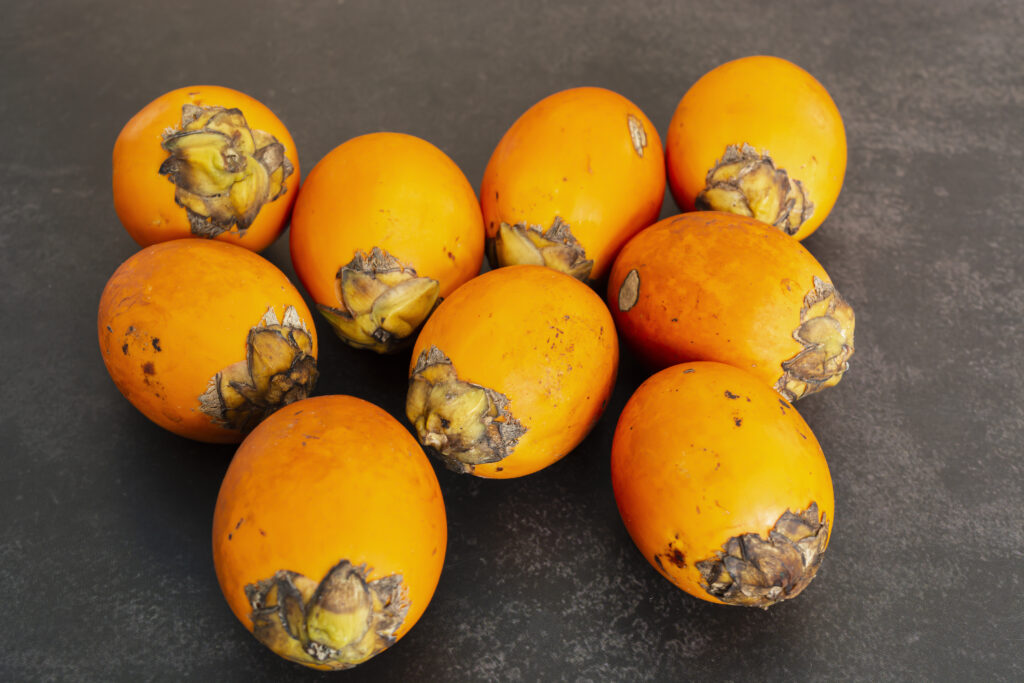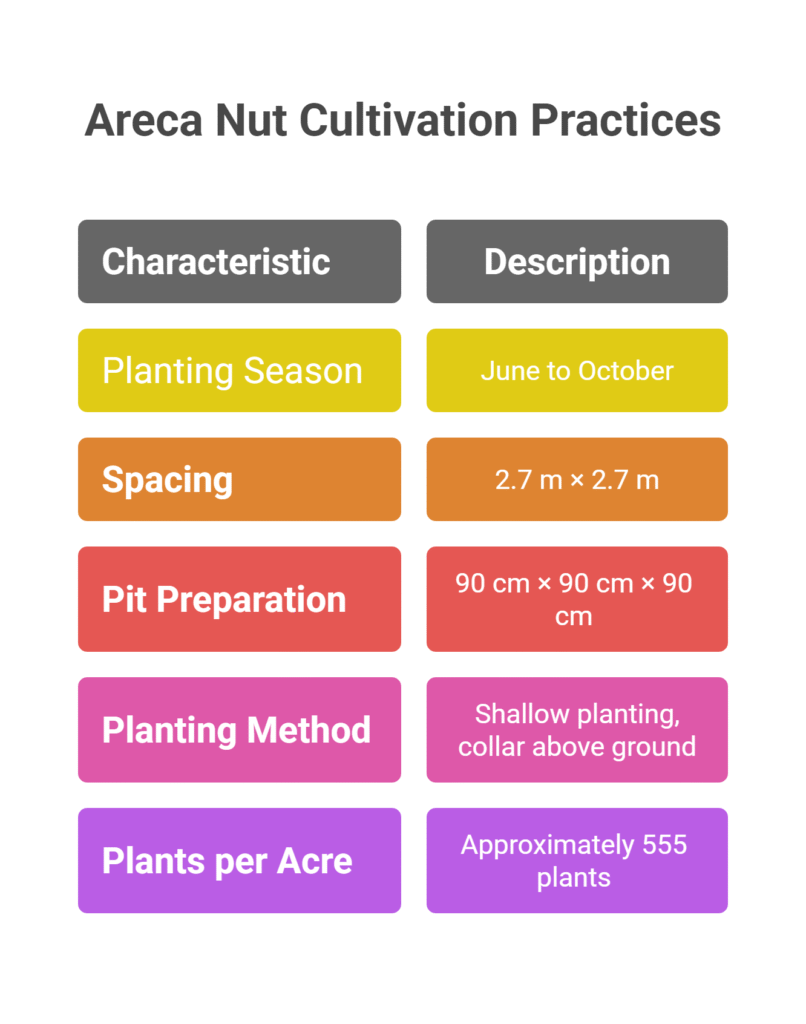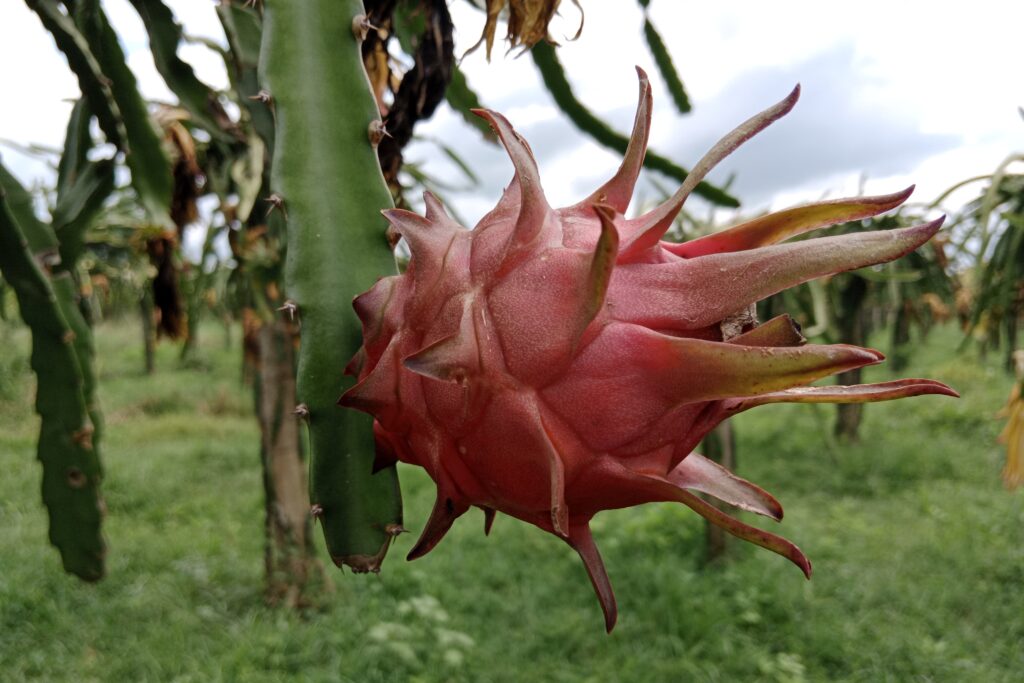Arecanut Farming
Arecanut Farming Profit Per Acre begins with an initial investment of approximately NRs. 492,500 per acre, covering key expenses such as land preparation, purchase of arecanut saplings, application of fertilizers and manure, installation of irrigation systems, and labor for planting and maintenance.
From the second year onward, farmers should expect an annual maintenance cost ranging between NRs. 50,000 to 100,000 per acre, depending on input costs, labor availability, and farm management efficiency.

The breakeven point is typically achieved by the 7th year, as the cumulative income reaches around NRs. 493,950, marginally surpassing the initial capital outlay. The most lucrative phase of cultivation spans from the 11th to the 40th year, during which farmers can earn up to NRs. 485,625 annually per acre. Even after deducting the highest estimated maintenance cost of NRs. 100,000, the net profit remains considerable at NRs. 385,625 per year. Hence, Arecanut Farming Profit Per Acre is highly promising over the long term, delivering steady and substantial returns when the plantation is managed efficiently and market conditions are favorable.
Land Preparation
Land preparation involves several critical steps to ensure optimal soil conditions for planting. Initially, all existing vegetation, including trees, bushes, weeds, stumps, and roots, must be thoroughly cleared. The land should then be leveled to facilitate proper irrigation and avoid water stagnation, though gentle slopes can be acceptable if drainage is adequate.
Deep ploughing, at a depth of 30–45 cm (1–1.5 ft), is performed once or twice to break hardpans, improve soil aeration, and incorporate organic matter. This is followed by harrowing to break down clods and achieve a fine tilth suitable for pit digging. Finally, broad and shallow basins are formed around each planting site to retain irrigation water during the initial years, and contour bunds may be established on sloped areas to control erosion.
Soil Type
Arecanut palms prefer deep (at least 2 meters), well-drained, fertile loamy soils that range from sandy loam to clay loam and are rich in organic matter. Laterite soils, also known as red soils, are prevalent in growing regions, but they are acceptable as long as they are sufficiently deep and regularly supplemented with organic matter.
With a range of 6.0 to 7.0 being the ideal, the pH of the soil should be slightly acidic to neutral, ideally between 5.0 and 8.0. Because even short bursts of waterlogging are fatal to the palms, there must be efficient drainage; heavy clay soils that are prone to stagnation, low-lying regions, and soils with a high-water table must all be avoided.
Climatic Requirements
| Climatic Factor | Requirement Details | |
| Temperature | Warm and humid conditions. | |
| Optimal Range: 15°C (59°F) to 38°C (100°F). | ||
| Critical Limits: Below 10°C (50°F) causes chilling injury; frost is fatal. Prolonged exposure above 40°C (104°F) damages palms, especially young ones. | ||
| Rainfall | Requirement: High and well-distributed. | |
| Optimal Annual: 1500 mm to 4500 mm. | ||
| Distribution: Ideally spread over 8-9 months. A distinct 2–3-month dry spell benefits flowering but requires irrigation. | ||
| Humidity | High relative humidity (70-90%) is crucial for optimal growth and nut development. | |
| Altitude | Typically, sea level is up to 1000 meters (3280 ft). | |
| Commercial Preference: Most plantations are below 700 meters (2300 ft). | ||
| Sunlight | Young Palms: Thrive under filtered sunlight. | |
| Mature Palms: Tolerate full sun but benefit from partial shade in very hot regions. | ||
| Traditional Practice: Often grown under natural canopy or with shade trees. | ||
Major Cultivars
Cultivar selection is often region-specific and primarily depends on factors such as yield potential, nut size and quality, disease resistance, and adaptability to local growing conditions.
| Region | Cultivar | Characteristics | Remarks |
| India (Major Growing Country) | Mangala | Early bearing, high-yielding, semi-tall | Popular in Karnataka |
| Sumangala | High-yielding, regular bearer, tolerant to moisture stress | Grown in Karnataka & Kerala | |
| Mohitnagar (West Bengal Tall) | Tall, vigorous, high-yielding, widely adaptable | Major cultivar in West Bengal and Assam | |
| Sree Mangala | Dwarf/semi-dwarf, early bearing, high yielding, suitable for high-density planting | Developed by CPCRI (India) | |
| Thirthahalli | Good adaptability and performance | Popular in Karnataka | |
| SAS-1, Hirehalli Dwarf | Regional selections | Grown in specific areas | |
| Other Regions | Local Selections | Adapted to regional conditions | Dominant in Bangladesh, Indonesia, Myanmar, etc. |
Planting
a). Planting Season
Areca nut is typically planted during the monsoon season, from June to October, when soil moisture conditions are favorable for successful establishment.

b) Spacing
In areca nut cultivation, the standard spacing is 2.7 m × 2.7 m, and rows should be aligned in an east-west direction to ensure maximum sunlight exposure for optimal growth.
c) Pit Preparation
For areca nut cultivation, pits of size 90 cm × 90 cm × 90 cm should be dug 1–2 months before planting to allow proper weathering. Each pit should be filled with a mixture of the original topsoil, 15–20 kg of well-rotted farmyard manure or compost, 1 kg of bone meal or rock phosphate, and optionally 1 kg of neem cake or castor cake for pest and disease suppression.
It is also recommended to add 100 g of mycorrhizal fungi inoculum to boost root growth and nutrient uptake, along with 50 g of Trichoderma viride for disease control. The pit should be filled slightly above ground level to accommodate future settling.
d) Planting Method
Use sturdy seedlings that are 12 to 18 months old. To prevent rot, plant shallowly and place the collar at or slightly above ground level. In the prepared pit, dig a tiny hole that is only a little bit bigger than the root ball. Firm the soil slightly, water well, and stake tall or weak seedlings. Mulch the base to keep it moist and keep weeds out.
e) Number of Plants per Acre
With the standard spacing of 2.7 m × 2.7 m, an acre can accommodate around 555 areca nut plants.
Intercropping
Intercropping in areca nut plantations is commonly practiced during the initial 1–5 years before the canopy closes, using the space between young palms to grow shade-tolerant or low-growing crops such as banana, pineapple, ginger, turmeric, elephant foot yam, black pepper, cocoa, betel vine, legumes, and medicinal plants.
This provides additional income, conserves soil moisture, suppresses weeds, and improves soil fertility. However, care must be taken to avoid deep-rooted or tall crops that compete with palms, and to ensure adequate water and fertilizer for both main and intercrops. Intercropping should be stopped once the canopy closes, typically by 5–7 years.
Irrigation
Irrigation is crucial in areca nut cultivation, particularly during dry months and for young palms in their first five years, as water stress can significantly reduce yield. Young palms (1–3 years) should be irrigated every 3–4 days in summer and weekly in winter, while bearing palms require watering once a week in summer and every two weeks in winter, with increased frequency during the nut development stage (January to May in India).
Basin irrigation is the most common method, where water is filled in basins around each palm, while drip irrigation offers greater efficiency, saving 30–50% water and enabling fertigation, especially useful in uneven or water-scarce areas. Water requirements vary, but adult palms generally need around 150–200 liters per irrigation, ensuring moisture reaches a depth of 50–60 cm.
Fertilizer and Manure
Fertilizer and manure should be applied annually to bearing areca nut palms, with the exact amounts tailored according to soil test results to ensure precise nutrient management. The typical fertilizer recommendations are outlined in the table below.
| Aspect | Details |
| Organic Foundation | 15-20 kg FYM/compost per palm annually |
| NPK Requirements | • Nitrogen (N): 100g (yield boost) • Phosphorus (P₂O₅): 40g (root/shoot development) • Potassium (K₂O): 140g (nut quality/size, disease resistance) |
| Application Schedule | • May-Jun (Pre-Monsoon): ⅓ N + ⅓ P + ⅓ K + Full organic manure • Sep-Oct (Post-Monsoon): ⅓ N +⅓ P+ ⅓ K • Dec-Jan (Winter): ⅓ N + ⅓ P + ⅓ K |
| Application Method | • Apply in a 30-45cm wide ring, 15-30cm from the palm base • Incorporate lightly into soil + irrigate • Drip systems: Fertigation in small, frequent splits |
| Micronutrients | • Correct Mg/Zn/B deficiencies via leaf analysis • Apply via foliar sprays or soil application |
Weed Control
| Weed Control Method | Description |
| Mulching | Effective for conserving soil moisture and suppressing weeds around the palm base. Use organic materials like dried leaves, straw, or coir pith. |
| Manual Weeding | Regular hand weeding or hoeing within a 1–1.5 m radius around the basin is essential, especially in young plantations. Conduct 4–6 times per year. Avoid root damage. |
| Mechanical Weeding | Tractor-drawn implements or power weeders can be used in the inter-row spaces of mature plantations for efficient weed control. |
| Chemical Control (Herbicides) | · Pre-emergence: Apply Diuron (Karmex) or Oxyfluorfen (Goal) on clean, moist soil in basins to control germinating weeds. Should be used cautiously near palms. · Post-emergence: Glyphosate (Roundup) may be used as a direct spray on weeds. Use a shield to avoid drifting onto palm foliage/stem, especially risky near young palms. Avoid contact with palm stems/roots. |
| Cover Crops | Growing leguminous cover crops in inter-row spaces helps suppress weed growth and enhances soil fertility. |
Pest and Disease Management
Common Pests
a). Spindle Bug/Inflorescence Caterpillar
The spindle bug or inflorescence caterpillar is a pest whose larvae bore into the inflorescence or spindle of areca nut palms, causing damage to the developing flowers. Effective control measures include maintaining field sanitation, using pheromone traps, releasing Trichogramma wasps as a biological control, and spraying insecticides such as Spinosad or Emamectin benzoate.
b). Scale Insects
Scale insects often lead to the development of sooty mold on areca nut palms, which affects photosynthesis and overall plant health. Effective control includes encouraging natural predators like ladybugs and applying neem oil or paraffinic oil sprays to manage infestations.
c). Mites
Mite infestations in areca nut palms cause leaf bronzing, which can reduce the plant’s vigor and productivity. Control measures include spraying with wettable sulfur, Dicofol, or Abamectin to effectively manage the pest.
d). Root Grubs
Root grubs are underground pests that feed on areca nut roots, causing palm weakening, yellowing, and reduced growth. Control measures include soil drenching with Chlorpyrifos (used with caution due to restrictions) and neem cake application, which offers a safer, eco-friendly alternative while also enriching the soil. Regular monitoring and good field hygiene help prevent infestations.
Common Diseases
a). Foot Rot
Foot Rot is widely regarded as the most devastating fungal disease affecting areca nut plantations, characterized by the appearance of dark, water-soaked lesions near the base of the stem that ooze a characteristic rusty-brown or reddish “bleeding” fluid; this infection rapidly progresses, leading to severe tissue decay, canopy wilting, and ultimately palm death if uncontrolled.
Effective management is paramount and begins with strict preventive measures: ensuring excellent field drainage is critical to eliminate excess moisture that favors the pathogen, and avoiding any mechanical injury to the stem base during cultivation activities is essential to prevent infection sites.
Curative control involves thoroughly drenching the soil and stem base around infected palms using chemical fungicides such as Bordeaux mixture (1%) or systemic options like Fosetyl-Al or Metalaxyl-M. Severely infected palms showing extensive damage and advanced bleeding must be promptly uprooted and destroyed to prevent further spread of the disease within the plantation.
b) Stem breaking
Stem breaking in areca nut palms, often caused by sun-scorch due to intense South-West sunlight, can be prevented by wrapping the exposed green portion of the stem with protective materials such as dry leaves, coir, or shade net. This helps shield the stem from direct sunlight, reduces heat stress, and prevents tissue damage that may lead to cracking or breakage.
c). Bud Rot
Bud rot is a serious disease in areca nut palms characterized by the rotting of the terminal bud, which can eventually lead to the death of the palm if not managed promptly. The disease is often aggravated by poor drainage and high humidity, making it essential to improve soil drainage and aeration to reduce the risk of infection.
Management involves the immediate removal of infected and decayed tissues from the crown, followed by the application of 10% Bordeaux paste directly into the crown area to disinfect the site. Additionally, preventive and curative sprays using systemic fungicides such as Fosetyl-Al or Metalaxyl-M are recommended to control the spread of the disease and protect healthy palms. Regular monitoring and good plantation hygiene are also crucial in minimizing bud rot incidence.
d). Koleroga (Fruit Rot)
Koleroga (fruit rot) causes devastating water-soaked spots on areca nuts, leading to premature shedding; control requires spraying 1% Bordeaux mixture before the monsoon onset and repeating applications 2–3 times during the rainy season, promptly removing and destroying infected nuts to eliminate sources of infection, and maintaining strict field sanitation and drainage to suppress disease spread.
e). Anabe Roga
Anabe Roga is a disease in areca nut palms often associated with potassium (K) deficiency or a complex of nutritional imbalances that affect the palm’s health and productivity. Symptoms may include yellowing, poor nut development, and overall decline in vigor.
Effective control of Anabe Roga involves ensuring adequate potassium fertilization tailored to the palm’s needs, based on soil and leaf nutrient analysis. Additionally, managing other essential micronutrients through balanced fertilization helps improve the palms’ resistance and recovery.
Regular monitoring of nutrient status and timely corrective measures are crucial to prevent and manage this disorder, thereby maintaining healthy growth and optimal yield.
Harvesting
Areca nut harvesting begins 4–8 years after planting, with peak yields from 15 to 40 years. Harvest stage depends on use: tender nuts for chewing are picked 5–7 months after flowering, when green and soft, while ripe nuts for drying (chali) are harvested after 8–9 months, when the husk turns yellow/orange and the nut hardens.
Harvesting is done year-round in staggered cycles every 4–8 weeks, with peaks during certain periods. Skilled climbers use ladders or climb palms to cut bunches with a sickle, and safety harnesses are advised. Yields range from 500 to 4000 kg/ha annually, averaging 1000–2000 kg/ha (400–800 kg/acre). Post-harvest, tender nuts are sold fresh, while ripe nuts are dehusked, optionally boiled, and sun-dried for 30–50 days (or artificially dried at 45–50°C during the monsoon), then graded and packed for storage or sale.
Cost of Investment Per Acre of Areca nut farming
| S.N. | Categories | Estimated Cost (NRs.) |
| 1 | Land Preparation (plowing, leveling, pits) | 20,000 |
| 2 | Arecanut Saplings | 111,000 |
| 3 | Fertilizers and Manure | 166,500 |
| 4 | Irrigation (Drip System) | 150,000 |
| 5 | Labor Costs (Planting, Weed Management) | 15,000 |
| 6 | Pest & Disease Control | 10,000 |
| 7 | Miscellaneous (Pesticides, Equipment, etc.) | 20,000 |
| Total Initial Investment | 492,500 |
Annual maintenance Cost
The expected yearly maintenance costs for areca nut farming per acre start in the second year and range from NRs. 50,000 to 100,000. This price covers standard farming operations like fertilizer application, irrigation, disease and insect control, weeding and pruning labor, and general plantation maintenance. Planting density, plantation age, input costs, and the degree of mechanization or manual labor employed in management are some of the variables that can affect the precise amount.
Income from one acre of Areca nut Farming
| Year | Yield per Tree (Kg) | Yield per Acre (Kg) | Price (NRs. /Kg) | Income per Acre (NRs.) |
| 4th Year | 0.2 | 111 | 200 | 22,200 |
| 5th Year | 0.5 | 277.5 | 200 | 55,500 |
| 6th Year | 1.0 | 555 | 250 | 138,750 |
| 7th–10th | 2.0 | 1110 | 250 | 277,500 (per year) |
| 11th–40th | 3.5 | 1942.5 | 250 | 485,625 (per year) |
| 41st–50th | 2.0 | 1110 | 300 | 333,000 (per year) |
Analysis of Areca Nut Farming Profit Per Acre
The initial investment for areca nut farming per acre is approximately NRs. 492,500, with an annual maintenance cost ranging from NRs. 50,000 to 100,000 starting from the second year. The breakeven point is typically reached by the 7th year, as the cumulative income of NRs. 493,950 slightly surpasses the initial investment. The peak income period spans from the 11th to the 40th year, during which farmers can earn around NRs. 485,625 per year. Even after accounting for the highest estimated maintenance cost of NRs. 100,000, the net annual profit during this period remains substantial at NRs. 385,625.
Sources
National Horticulture Board, India. (2022). Intercropping Models for Young Arecanut Plantations.


